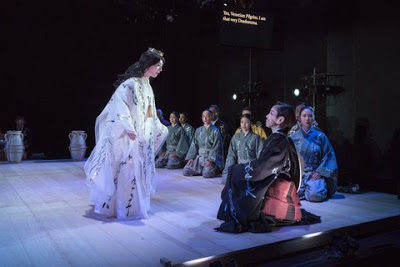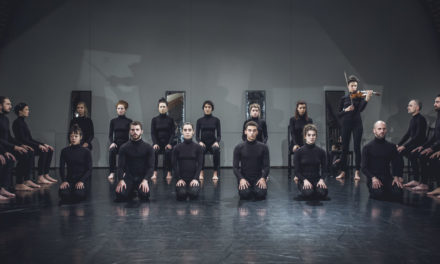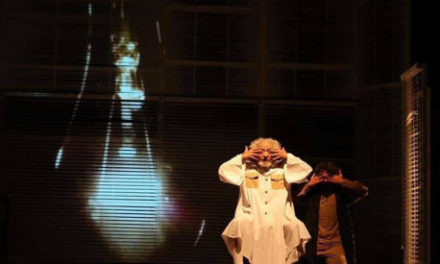New York City’s Japan Society closed out its 2017-18 Noh-Now series this past January with renowned director Satoshi Miyagi’s Mugen Noh Othello. I was fortunate to see this compelling noh-inspired piece, remounted by Shizuoka Performing Arts Center (SPAC), where Miyagi has served as the Artistic Director since 2007. Shifting focus from the Moor of Shakespeare’s tragedy to that of his ill-fated and “un-notable” wife, Desdemona, Mugen Noh Othello presents an innovative reimagining that keenly considers the tale from the point of view of Othello’s victims.
Mugen Noh Othello is the third time Miyagi’s work has appeared at the Japan Society (Tenshu Monogatari in 2003 and Medea in 2011) and represents the organization’s commitment to long-term collaboration with many Japanese artists of note. Artistic Director, Yoko Shioya’s, commitment to bringing unique Japanese theater to NYC and providing an “incubator” for the artists of these productions is giving New Yorkers a chance to see some cutting-edge theatre you won’t see anywhere else. Originally performed by Miyagi’s theater group, Ku Na’uka, in 2005, I think this new version of Mugen Noh Othello brings some exciting revisions to the stage and provides some additional dramaturgical heft to an already intriguing production.
The production retains the basic plot of the previous version, which mirrors the dramaturgical structure of a mugen noh. This type of two-act Noh play (often including an ai-kyōgen, or intermission section, in between acts) often features the ghost of a notable figure–in this case, Desdemona–whose unresolved regrets cause their spirit to haunt the contemporary world of the play. After meeting with a Pilgrim who is curious about her, Desdemona reveals herself to be a restless spirit and exits, ending the first act. After the ai-kyogen, which provides clarification of the events the first act alluded to, Desdemona returns in the second act to replay her trauma: the incident in which Othello mistakenly strangles her in a fit of misplaced jealousy.
As Miyagi notes, strictly speaking in terms of Shakespeare’s play, Desdemona is not the kind of legendary figure a mugen noh typically deals with–but for Miyagi that is the point. As he states in his recent director’s note:
Most of us in the audience are insignificant human beings who will leave no impact on their country or history. The troubles of such insignificant humans cannot elicit sympathy from historic giants and heroes; and so, it is unrealistic for us to share our stories with them.
For Miyagi, it is precisely because Shakespeare’s treatment of Desdemona has rendered her “unremarkable” that her story becomes one we can sympathize with. In our ability to relate to Desdemona’s marginalized position, Desdemona becomes an appropriate mugen noh protagonist.
While Desdemona’s role has remained consistent, this new offering has built clearer boundaries between the ai-kyōgen section and the noh acts. Along these lines, while Desdemona was on-stage during almost all of the ai-kyōgen of the 2005 production, her presence in the new version has been limited to a single part towards the end, making the play’s structure operate more like a typical mugen noh. Miyagi has also added other noh elements, including the actors’ use of suriashi (noh sliding step) and costuming inspired by noh conventions.
Equally interesting is the considerable overhaul playwright Suehiro Hirakawa did on the script itself. Hirakawa added thought-provoking new dialogue in the first act and completely rewrote the ai-kyōgen.
Based on the first production, I believe it can be said Hirakawa has always been interested in exploring Desdemona’s victimization. However, with new text in the first act, Hirakawa expands his scope, including the women of Cyprus as extended casualties of Othello’s transgression. Upon meeting the Venetian Pilgrim, the women of Cyprus now reveal that, thanks to the Turkish occupation following Othello’s death, they have been forced into prostitution. Following this revelation, Desdemona appears from within the group, effectively creating a shared connection between her and the wronged women of Cyprus.
The ai-kyōgen no longer works with Act IV of Othello, which specifically presents Othello’s processing of Iago’s lies. Instead, it focuses on the events leading up to this moment and addresses Desdemona’s wooing and Iago’s machinations (Acts I and III). This clever refocusing diminishes Othello’s role and reduces his ability to elicit sympathy, making his character entirely defined by the act of violence he commits against Desdemona. Iago, while an outright villain in the 2005 production, has been transformed into a manzai-like comedian. His scheming with Roderigo mimics the classic manzai boke (funny man, Iago) and tsukkomi (straight man, Roderigo) stand-up routine and this lighthearted approach coyly breaks the dramatic tension of the noh while not diminishing its impact once it resumes.
Miyagi’s directorial response to this new material provides an equally thought-provoking dimension to the play, particularly in his expansion of the Chorus’ role. While the 2005 production limited much of the Chorus’ speaking to that of narrators, providing background information when necessary, in this production, Miyagi has more extensively used his trademark futari hitoyaku or “two actors, one role” directing style to suggest there is a common thread which enables Desdemona’s trauma to echo throughout the Cyprus community. At times, Desdemona’s lines are spoken by a Chorus member while Desdemona pantomimes actions and, like in a noh play, the Chorus often provides many of Desdemona’s inner thoughts. This adept layering of voices transforms Desdemona from an individual ghost bound by Othello’s crimes into a figure who represents a community of victims.
Reprising her role as Desdemona is the incomparable Micari. In Act I, Micari’s rigid posture and almost mechanical movement suggest that she herself is bound by some unseen force. While the leading role in a mugen noh (shite) typically wears a mask, Micari does not. However, due to the expert control she had over facial expression, I actually thought she was wearing one when she first appeared. Additionally, much like a master noh performer, it is clear there was an incredible amount of energy being contained within each of her steps, gestures, and facial expressions. In Act II, Micari’s utilization of contemporary and classical Japanese dance (nihon buyō) transformed her from a stiff doll into an undulating spirit–her body pulled in opposing directions by her soul’s desire to be free and the reality of her demise tethering her to the world of the living.
Supporting the chorus and the performers is another of Miyagi’s trademark performance elements, an indispensable group of percussionists. While none of the instruments in the 2005 production or in this one would be found on a noh stage, the rhythms created to support the dramatic action throughout the performance and provide masterful rises and falls in tension.
I can definitely say Miyagi’s production has been one of the most rewarding to date. The play’s deft communication with noh moved beyond mere stylistic mimicry and enabled me to enjoy a familiar story in a new way and from a different perspective. Also, as Miyagi is not shy when it comes to embracing the theatricality of the stage, Mugen Noh Othello is particularly refreshing in a world of living-room-theater, superhero melodramas, and talking heads. This was definitely a story that could only be told on the stage and I appreciated that Miyagi made big, bold, choices–not only with the narrative–but with the acting, with the music, and with the ways he chose to engage noh.
If SPAC’s Mugen Noh Othello comes your way, I absolutely recommend it.
If you are interested in watching the 2005 Ku Na’uka production, you can do so online here.
This post was written by the author in their personal capacity.The opinions expressed in this article are the author’s own and do not reflect the view of The Theatre Times, their staff or collaborators.
This post was written by Alex Rogals.
The views expressed here belong to the author and do not necessarily reflect our views and opinions.

















